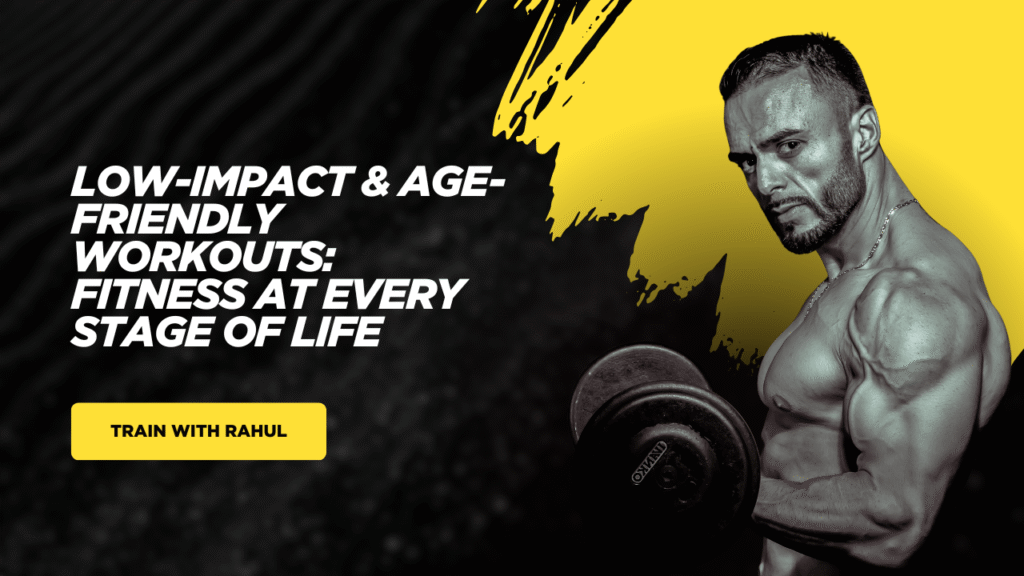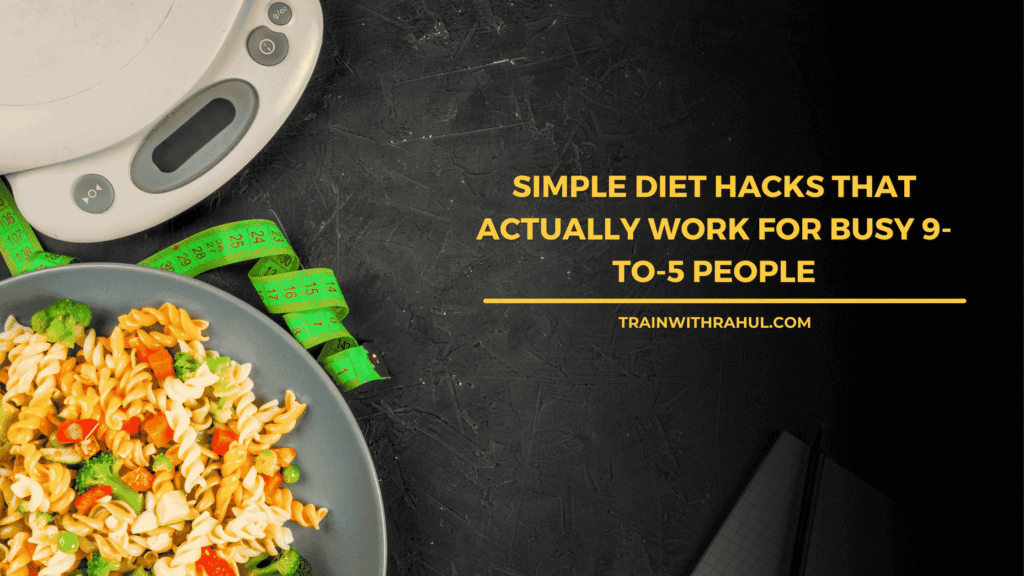Published by Train with Rahul | June 2025
In today’s fast-paced fitness culture, the spotlight is often on high-intensity interval training (HIIT), CrossFit, and extreme transformation programs. But as more people seek sustainable, long-term approaches to health, a quieter revolution is reshaping the fitness world—low-impact and age-friendly workouts.
Whether you’re recovering from an injury, returning to exercise after a long break, or simply want a joint-friendly fitness routine, low-impact workouts offer benefits that extend beyond fat loss and muscle gain. These workouts focus on mobility, balance, mental clarity, and overall wellness, making them ideal for beginners, older adults, and anyone seeking a gentler way to stay fit.
Why Low-Impact Fitness Is Gaining Momentum
1. The Shift Towards Longevity
As global life expectancy increases, so does the demand for fitness routines that prioritize mobility, balance, and functional strength. The focus is shifting from short-term aesthetics to long-term independence and vitality. Fitness is no longer just about “six-packs” and weight loss—it’s about aging well, staying pain-free, and living actively at every age.
2. Fitness for All
Low-impact workouts are inclusive, meaning anyone—from sedentary individuals to seniors—can start without fear of injury or overwhelm. This inclusivity opens the door to fitness for people who may have previously been left out, including those with joint issues, obesity, or health conditions like arthritis or osteoporosis.
3. Rise of Recovery & Holistic Wellness
The popularity of mindfulness, recovery tools, and mental wellness is leading to the growth of low-impact workouts like yoga, tai chi, and Pilates. These exercises not only protect joints but also enhance mental clarity, reduce stress, and promote mindfulness—a holistic approach to fitness that is more sustainable.
What Exactly is a Low-Impact Workout?
A low-impact workout is any exercise where one foot stays in contact with the ground at all times, or the body experiences minimal impact on joints. These routines focus on controlled movements, low force, and slower tempo, making them ideal for older adults, those recovering from injury, and beginners.
Common examples include:
- Brisk walking
- Stationary or recumbent biking
- Chair yoga or gentle floor yoga
- Water aerobics or swimming
- Pilates (including chair Pilates)
- Resistance band exercises
- Tai Chi or slow-paced dance workouts
The Benefits of Low-Impact, Age-Friendly Workouts
1. Joint-Friendly
Unlike jumping or running, low-impact exercises do not strain your knees, hips, or spine. This makes them safe for those with arthritis, knee pain, or past injuries.
2. Boosts Cardiovascular Health
Even without jumping, these workouts elevate your heart rate gradually, improving blood flow, lung capacity, and heart health. A brisk 30-minute walk daily can reduce the risk of heart disease, stroke, and diabetes.
3. Improves Balance & Prevents Falls
Balance-focused movements like tai chi, Pilates, and yoga strengthen stabilizing muscles and reduce fall risks—especially crucial for seniors.
4. Enhances Mental Health
Gentle workouts help reduce anxiety, promote better sleep, and boost cognitive function. They’re particularly effective for people dealing with depression, ADHD, or chronic stress.
5. Builds Functional Strength
Low-impact resistance training improves core strength, joint stability, and posture. Over time, this supports everyday tasks like climbing stairs, lifting groceries, and maintaining independence.
6. Easy to Stay Consistent
Because these routines are gentler and less draining, it’s easier to stay consistent. You’re less likely to feel burned out, injured, or intimidated.
Trending Low-Impact Workouts in 2025
1. The 12-3-30 Treadmill Workout
Popularized on social media, this routine involves walking on a treadmill at a 12% incline, at 3 mph, for 30 minutes. It’s simple, joint-friendly, and great for fat loss, leg strength, and cardiovascular endurance.
2. Aqua Workouts
Whether it’s swimming laps, water aerobics, or aqua board fitness, water workouts are joint-supportive and effective. Water adds resistance while keeping impact minimal.
3. Recumbent Biking
A great indoor cardio option for seniors or those with hip/knee issues. It improves circulation, leg strength, and endurance while reducing pressure on the joints.
4. Pilates and Chair Pilates
Pilates strengthens the core, improves posture, and enhances balance. Chair Pilates is especially designed for older adults, offering a safer and more supported version of traditional moves.
5. Resistance Band Workouts
These elastic bands offer a safe and customizable form of resistance training. They’re affordable, easy to store, and suitable for home use.
6. Japanese Interval Walking
Also known as “interval walking training,” this method alternates three minutes of fast walking with three minutes of relaxed walking. It’s shown to improve blood pressure, endurance, and insulin sensitivity.
7. Chair Yoga & Seated Stretching
Ideal for those with limited mobility. These sessions emphasize deep breathing, flexibility, and slow stretching, improving mobility and reducing joint stiffness.
A 7-Day Sample Routine for Beginners and Seniors
| Day | Routine | Duration |
|---|---|---|
| Monday | 12-3-30 Incline Walk | 30 min |
| Tuesday | Chair Pilates + Resistance Bands | 30 min |
| Wednesday | Recumbent Bike + Core Stretching | 30 min |
| Thursday | Japanese Interval Walking | 30 min |
| Friday | Aqua Aerobics or Pool Walking | 30 min |
| Saturday | Chair Yoga + Light Strength Training | 25–30 min |
| Sunday | Rest or Casual Nature Walk | 20–30 min |
This weekly plan promotes consistency, mobility, and safe progress.
Essential Equipment for Low-Impact Fitness at Home
You don’t need a fully equipped gym to start. Here’s a list of simple, affordable tools:
- Resistance bands
- Recumbent bike or stepper
- Yoga mat and chair
- Dumbbells (1–5 kg)
- Treadmill with incline (optional)
- Stability ball
- Water dumbbells (for aqua workouts)
If you’re in India, check online marketplaces like Amazon India, Decathlon, or local fitness retailers for low-budget options.
Who Should Do These Workouts?
Low-impact and age-friendly workouts are ideal for:
- Adults over 50
- Beginners getting back into fitness
- Pregnant or postpartum women
- People with joint pain or injury
- Overweight individuals easing into exercise
- Anyone looking to stay active without stress
Safety Tips Before You Begin
- Consult a healthcare professional before starting any new fitness program, especially if you have chronic conditions.
- Warm up and cool down properly to avoid stiffness or soreness.
- Hydrate regularly, especially in warm climates or post-menopause.
- Listen to your body—stop if you feel dizzy, short of breath, or in pain.
- Use supportive shoes and mats to reduce the risk of slipping or injury.
- Modify as needed—never push through pain. Adapt moves to your range of motion.
Final Thoughts
Low-impact workouts aren’t just an alternative—they are the future of sustainable fitness. In a world that’s finally prioritizing mental health, injury prevention, and longevity, low-impact routines offer a powerful, inclusive way to stay active.
Whether you’re 25 or 75, you deserve a workout that helps you move better, feel better, and live longer.
Looking for a personalized low-impact plan?
Join the Train with Rahul community today and receive customized workout routines, video tutorials, and coaching that suits your age, fitness level, and goals.
Have questions? Drop them in the comments or reach out on Instagram at @rahulxalpha.
Let me know if you want this blog formatted for WordPress or with visuals (e.g., infographics, thumbnails). I can also convert it into a downloadable PDF lead magnet for your email list.


